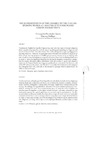Identificador persistente para citar o vincular este elemento:
https://accedacris.ulpgc.es/jspui/handle/10553/58701
| Título: | The representation of the Canaries to the English-speaking world: an analysis of the discourses used in tourist texts | Autores/as: | Hernández Guerra, Concepción Mulligan, Maureen |
Clasificación UNESCO: | 57 Lingüística | Palabras clave: | Discourse Genre Function Tourist texts Discurso, et al. |
Fecha de publicación: | 2011 | Publicación seriada: | Revista de Filología de la Universidad de La Laguna | Resumen: | Tradicionalmente, el Inglés para Fines Específicos ha abordado el estudio de los subgéneros textuales desde una perspectiva sincrónica, con el objeto de concretar y analizar, normalmente con fines pedagógicos o instructivos, los rasgos lingüísticos y estructurales que los definen. Sin embargo, las especificidades inherentes a los textos turísticos plantean la necesidad de investigarlos a partir de otros parámetros, pues, al tratarse de textos dirigidos a un colectivo poco homogéneo, se distinguen mucho más por la función comunicativa que desempeñan que por los rasgos lingüísticos o estructurales que los particularizan. Por ello, en este trabajo se ofrece un estudio diacrónico de un corpus de textos turísticos destinados a visitantes de las Islas Canarias correspondientes a un periodo que comprende desde finales del siglo XIX hasta nuestros días, con el fin de indagar en la evolución que ha experimentado este subgénero a lo largo del tiempo y en la tipología discursiva predominante en cada etapa. Traditionally, English for Specific Purposes has dealt with the study of textual subgenres from a synchronic perspective, with the aim of specifying and analyzing the linguistic and structural characteristics that define them. This is often designed to support pedagogical or teaching objectives. However, the particular nature of tourist texts means it is necessary to look at them from the perspective of different parameters, because, as we are dealing with texts aimed at a very heterogeneous range of consumers, these texts are distinguished more in terms of their communicative function than by purely linguistic or structural features. For this reason, this article offers a diachronic study of a corpus of tourist texts aimed at visitors to the Canary Islands, involving texts produced over a period of time from the end of the 19th century to the present day. The aim is to consider the evolution that this subgenre has undergone over time, and look at the discursive typology which is predominant in different historical stages. |
URI: | https://accedacris.ulpgc.es/handle/10553/58701 | ISSN: | 0212-4130 | Fuente: | Revista de Filología de la Universidad de La Laguna [ISSN 0212-4130] (29), p. 123-140 | URL: | http://dialnet.unirioja.es/servlet/articulo?codigo=3662497 |
| Colección: | Artículos |
Visitas
70
actualizado el 05-oct-2024
Descargas
43
actualizado el 05-oct-2024
Google ScholarTM
Verifica
Comparte
Exporta metadatos
Los elementos en ULPGC accedaCRIS están protegidos por derechos de autor con todos los derechos reservados, a menos que se indique lo contrario.
